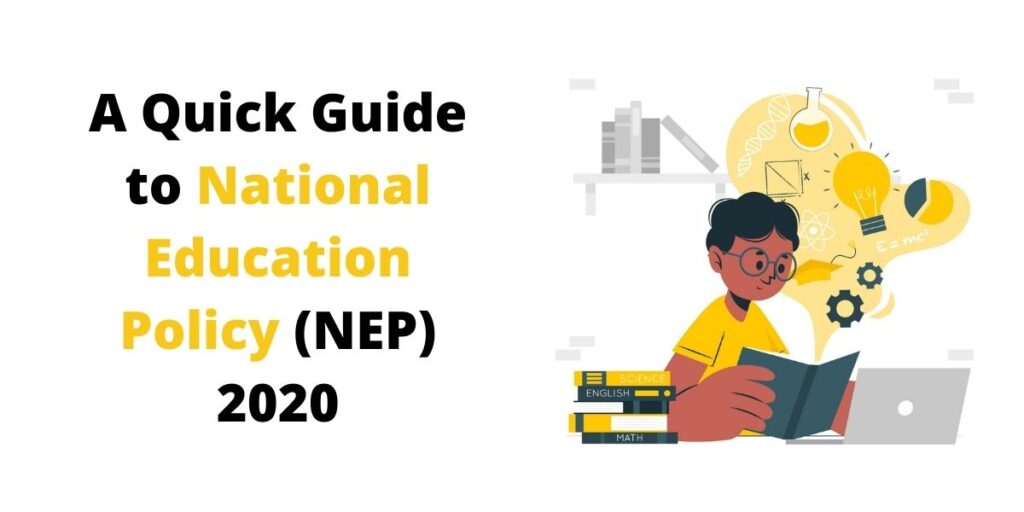A Quick Guide to National Education Policy (NEP) 2020

The United Cabinet passed an ambitious National Education Policy (NEP) in 2020, proposing a complete reform of the Indian education system. The policy aims to create a step-by-step approach for students and learning institutions and transform India into a vibrant knowledge center. It is built on the principles of “Accessibility, Equity, Quality, Affordability, and Accountability.”
This is the 1st education policy of the 21st century, replacing the 1986 NEP. 34 years later, the NEP was revised to reflect the changing needs of Indian students and to comply with international education standards.
NEP 2020 is a massive policy with many functions and action points. Following are some of the main features of this broad policy:
- According to NEP 2020, the existing 10+2 structure of school education will be replaced by the 5+3+3+4 system, covering ages from 3 to 18 years. This means that the first five-year school, including three-year preschool and classes 1 and 2, will be the foundation stage. In the next three years, classes 3 t o5 will be the preparatory stage, 6-8 classes are the mid-term, and 9-12 classes are the secondary stage.
- Children under 3 years old can learn basic learning courses at home, and children between 3 and 6 years old will have preschool courses.
- Starting from Class 6, students will receive vocational training at an early age.
- Each student has the opportunity to choose their favourite subjects from Class 8 to Class 12, which will allow them to specialize in the subjects of their choice.
- All graduation courses last for four years, which will give students plenty of time to master their respective subjects.
- For all graduate courses, there will be one main course to be their core subject and one minor course to be added to increase student interest in these subjects. For example, students majoring in mathematics may take music as a minor.
- Academic Credit Banks (ABCs) should be established to digitally store student academic loans from recognized Higher Education Institutions (HEIs).
- By 2040, all higher education institutions will be multidisciplinary institutions with a student population of 3,000 or more.
- The same grading model and rules will apply to all universities, whether they are public universities, private universities, considered/deemed to be universities, or open universities.
- Higher education institutions should also move from high-stakes testing to continuous and comprehensive assessments throughout the year.
- Students can enter and exit selected courses multiple times.
- After completing the one-year graduation course, students will receive a basic education certificate or diploma certificate upon completing the second year and a degree after completing the entire course. Thus, if students drop out in the middle of school, they will not lose any time.
- The campus provides students with a wide range of athletic, cultural, artistic, environmental, and community service clubs.
- Each educational institution will provide stress and emotional adjustment counseling.
- Several initiatives are being developed to ensure the survival, growth, and dynamism of all Indian languages. Higher education will have more programs using the mother tongue or local language as a medium of instruction.
- High-performing Indian universities will be encouraged to open campuses abroad.
- Universities among the top 100 universities in the world will also be allowed to operate in India.
- Every classroom should have access to the latest educational technology to improve learning.
- The policy aims to achieve a 100% literacy rate for youth and adults.
Advantages of NEP 2020
- The new 5+3+3+4 structure attaches great importance to early childhood education because the policy also includes early childhood care and education over 3 years old.
- The focus of this policy is to promote practical and application-based knowledge for learners.
- The policy aims to bring about 20 million students back to educational institutions through this new method.
- NEP 2020 will establish a multidisciplinary education and research university in India comparable to IIT and IIM. These universities will introduce multidisciplinary academic programs.
Disadvantages of NEP 2020
- Some academic experts believe that in most countries, the ideal school age for most countries is 4-6 years old, and starting school at 3 years old may be challenging for kids
- Due to the lack of teachers, the introduction of mother tongues for each subject in academic institutions may be a problem
- Grades 3, 5, and 8 exams may be stressful for students
- Increasing graduation age may cause students to lose motivation and withdraw from the course
Implementation of NEP 2020
NEP 2020 is a reform plan that will take time to implement. Although, according to the Indian government, NEP 2020 should be implemented by 2040. To reach the target year, the main points of the initiative must be implemented one by one. In addition, the proposed reforms will be implemented through a partnership between the federal and state governments and ensure that the federal and state governments will form a subject-specific committee to review the implementation plan.
In Summary
NEP 2020 aims to transform India’s current learning infrastructure and upgrade it to international academic standards, making India a vibrant knowledge hub. The policy aims not only to recognize, identify and cultivate the unique abilities of each student but also to provide high-quality education for each child and adult, thereby making India a global knowledge superpower.

